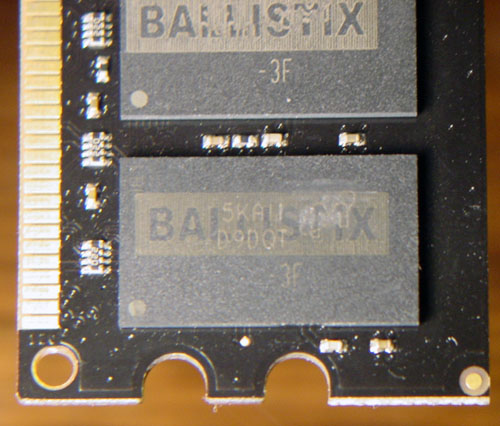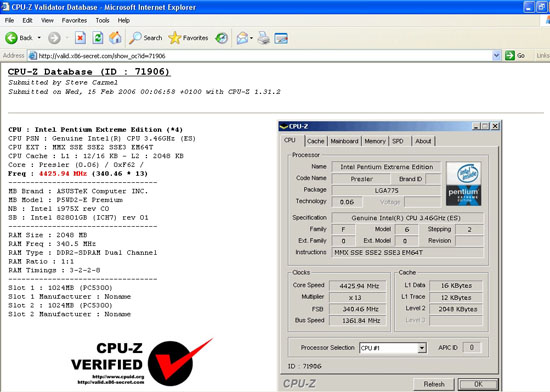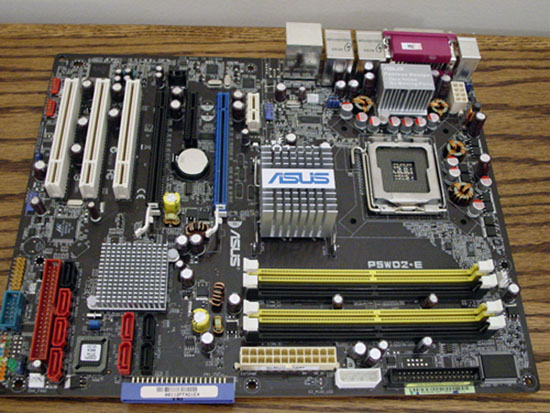Crucial Ballistix DDR2: The New DDR2 Standard?
by Steve Carmel & Wesley Fink on February 21, 2006 12:05 AM EST- Posted in
- Memory
The DDR2 market enjoyed some incredible DDR2 performance early in its life with a Micron DDR2 chip that we have since come to know as Fat Body D9. Everyone who made DDR2 used these chips because the performance was so outstanding, and when Micron decided to discontinue them last year, memory makers began scrambling for a replacement. Thus far, they haven't found a new DDR2 chip with the same low latency and high frequency capabilities of the now legendary Micron chips.
Two months ago, a new buzz began that Micron and their Crucial direct sales arm would be introducing a new and even better DDR2 memory chip. Every enthusiast memory maker with whom we talked about DDR2 was saying to wait until March when we have new high performance chips. Those chips, of course, are to be based on these new Micron DDR2 memory chips. When Crucial offered to send us their newest and top-performing DDR2 memory in early February, we couldn't wait to take a closer look. Were these the new Micron wonder DDR2?
In this review of two of the new Crucial Ballistix DDR2 kits, the biggest question on everyone's mind is: how will it compare to the legendary Fat Body D9 chips? Does it maintain tight timings at higher clock speeds? Is it still responsive to increased voltage like prior iterations of the Fat Body D9 made by Micron?
Crucial Technology's PC2-6400 has memory timings specified at 4-4-4-12 at speeds of DDR2-800. The other memory kit that Crucial sent along for testing was their PC2-5300, rated at DDR2-667 speeds with lower latency timings of 3-3-3-12.
What lies under the copper-colored, aluminum heat spreaders? Crucial Technology continues to use their trademark black PCB.
This depicts the PCB lurking underneath the Crucial Technology PC2-5300 DDR2 memory kit that we tested recently.
Closer examination of the IC's showed some distinctive markings, which can be used to help identify the integrated circuits that were used in construction of this particular memory module.
The 2nd row shows markings of D9DQT. Please note that the D9 is indicative of Micron's Fat Body integrated circuit. At the very bottom of the IC, there is a -3F marking, which is usually used for speed grading.
By entering the FBGA code into Micron's Part Marking Decoder, the search output was rather inconclusive. This part appears not to be in the Micron database yet. The restamping and lack of information from Micron keeps us wondering about the real speed of the new DDR2 Chips. Does this new die revision of the D9 IC's still contain 3.7ns chips as we saw with past D9?
With limited specifications and no memory ID that tells us anything, memory benchmarking is the only way to find out if the new memory from Crucial Technology can produce the widely anticipated results?
With the advent of the new 975X chipsets available on the market, this was a prime opportunity to test some new DDR2 modules from Crucial on this Intel based platform. AnandTech utilized the quite stable ASUS P5WD2-Premium motherboard, in conjunction with an Intel Pentium 955 Extreme Edition CPU, which sported a 1066MHz FSB dual core solution, containing a whopping 2MB of L2 cache onboard, as part of our testing platform. You can read our full Asus P5WD2-E Premium review here.
Asus advertises this particular motherboard in their February 2006 product information spreadsheet, claiming it as their flagship 975X motherboard with native DDR2 800 support. The chart below shows the myriad of memory options at different front side bus speeds available with this particular mainboard. The asterisks indicate settings provided for overclocking purposes only.
Two months ago, a new buzz began that Micron and their Crucial direct sales arm would be introducing a new and even better DDR2 memory chip. Every enthusiast memory maker with whom we talked about DDR2 was saying to wait until March when we have new high performance chips. Those chips, of course, are to be based on these new Micron DDR2 memory chips. When Crucial offered to send us their newest and top-performing DDR2 memory in early February, we couldn't wait to take a closer look. Were these the new Micron wonder DDR2?
In this review of two of the new Crucial Ballistix DDR2 kits, the biggest question on everyone's mind is: how will it compare to the legendary Fat Body D9 chips? Does it maintain tight timings at higher clock speeds? Is it still responsive to increased voltage like prior iterations of the Fat Body D9 made by Micron?
Crucial Technology's PC2-6400 has memory timings specified at 4-4-4-12 at speeds of DDR2-800. The other memory kit that Crucial sent along for testing was their PC2-5300, rated at DDR2-667 speeds with lower latency timings of 3-3-3-12.
What lies under the copper-colored, aluminum heat spreaders? Crucial Technology continues to use their trademark black PCB.

This depicts the PCB lurking underneath the Crucial Technology PC2-5300 DDR2 memory kit that we tested recently.
Closer examination of the IC's showed some distinctive markings, which can be used to help identify the integrated circuits that were used in construction of this particular memory module.

The 2nd row shows markings of D9DQT. Please note that the D9 is indicative of Micron's Fat Body integrated circuit. At the very bottom of the IC, there is a -3F marking, which is usually used for speed grading.
By entering the FBGA code into Micron's Part Marking Decoder, the search output was rather inconclusive. This part appears not to be in the Micron database yet. The restamping and lack of information from Micron keeps us wondering about the real speed of the new DDR2 Chips. Does this new die revision of the D9 IC's still contain 3.7ns chips as we saw with past D9?
With limited specifications and no memory ID that tells us anything, memory benchmarking is the only way to find out if the new memory from Crucial Technology can produce the widely anticipated results?
With the advent of the new 975X chipsets available on the market, this was a prime opportunity to test some new DDR2 modules from Crucial on this Intel based platform. AnandTech utilized the quite stable ASUS P5WD2-Premium motherboard, in conjunction with an Intel Pentium 955 Extreme Edition CPU, which sported a 1066MHz FSB dual core solution, containing a whopping 2MB of L2 cache onboard, as part of our testing platform. You can read our full Asus P5WD2-E Premium review here.
Asus advertises this particular motherboard in their February 2006 product information spreadsheet, claiming it as their flagship 975X motherboard with native DDR2 800 support. The chart below shows the myriad of memory options at different front side bus speeds available with this particular mainboard. The asterisks indicate settings provided for overclocking purposes only.
| FSB | Memory Configuration Options/ASUS P5WD2-E Premium Motherboard | |||||||
| Auto | DDR2-400 | DDR2-533 | DDR2-667 | DDR2-711* | DDR2-800* | DDR2-889* | DDR2-1067* | |
| FSB 1066 | * | * | * | * | * | * | * | * |
| FSB 800 | * | * | * | * | - | * | - | - |
| FSB 533 | * | * | * | - | - | - | - | - |













27 Comments
View All Comments
Griotspeak - Sunday, March 12, 2006 - link
2GB PC-5300 modules should be available?i KNOW there isnt much hope of a definite answer, but i'd like to have some idea since i could wait a month or so.
Regs - Saturday, February 25, 2006 - link
Maybe i'll wait until it has a use.pnyffeler - Thursday, February 23, 2006 - link
I'm feeling a little uncertain about why anyone would want to rush out and purchase a new AM2 system ASAP. What advantage would you gain over a 939 rig? Right now, DDR2 memory is loads more expensive than DDR, and according to Tom's Hardware's analysis, there isn't any advantage. Well, at least, not theoretically until DDR2-800 becomes available, but even so, are we going to see a significant increase in performance? It seems that the smart move is to set up a 939 system, dump it full of good, cheap DDR RAM, and save your pennies for the new DirectX 10 graphics card that will be available at the end of the year when Vista comes out. I just see DDR2 as the next logical transition, especially with chip makers changing over time to DDR2, but you won't see me jumping on the bandwagon any time soon....IntelUser2000 - Wednesday, February 22, 2006 - link
http://www.anandtech.com/memory/showdoc.aspx?i=270...">http://www.anandtech.com/memory/showdoc.aspx?i=270...WTF is up with this review in terms of spelling errors and inconsistencies??
The tightest timings are NOT the PC2-5300 kit according to the table, but RATHER THE OCZ DDR2 PC2-4200.
The only one I see that achieves 3-2-2-8 at FSB of 345 is OCZ DDR2 PC2-4200, not the Crucial PC2-5300 kit.
Plus, CONSISTENT spelling errors that say MB/s. I sure don't want my memory bandwidth to be single digit MB/s even on a 486 PC.
leexgx - Saturday, February 25, 2006 - link
what spelling errors (ram does not work at 9000GB/s) that result is right
IntelUser2000 - Tuesday, February 28, 2006 - link
I was likely referring to the fact that the table and the paragraph below is inconsistent. There are no such numbers on the table.
hwhacker - Wednesday, February 22, 2006 - link
He explains this in the article. Overclocking the FSB on intel's chips is different than on AMD chips. You can much finer tune an AMD because of the adjustable multiplier...unless you have mega-cooling to allow the processor to scale with the memory speed...It's kind of tough.RTFA. ;)
Marlowe - Wednesday, February 22, 2006 - link
They could reach 400 MHz mem easily with the 4:5 divider. (would require 320 MHz FSB)Marlowe - Wednesday, February 22, 2006 - link
Last time I checked DDR800 is 400 MHz real frequency. I've looked through the heap of hard to manage screenshots, (yes what happened to graphs?) but the highest I saw was 350 MHz. Did I miss something? Were you not able to reach 400 MHz?ATWindsor - Wednesday, February 22, 2006 - link
Why do I suddenly hae to enable referer logging to see the pictures in the article?